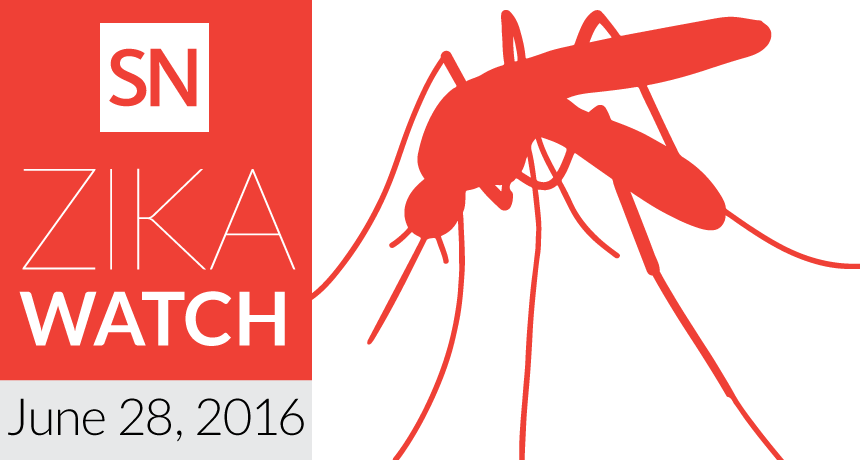This week in Zika: vaccine progress, infection insights

In the race to create a Zika vaccine, researchers face a marathon, not a sprint.
Developing and testing vaccines is a slow and laborious process, sometimes plagued by funding problems. (Case in point: On June 28, political disputes once again derailed vaccine research support when the U.S. Senate blocked a $1.1 billion Zika bill.)
A vaccine that’s safe and ready for use in humans could take years — potentially after the Zika epidemic has subsided.
This week, though, several bits of good news offer scientists a possible second wind even as reports about babies from Brazil and Colombia add new insight into the virus’s ill effects in utero.
-
Just a single shot of either of two Zika vaccines can protect mice from the virus, Harvard Medical School vaccine researcher Dan Barouch and colleagues report June 28 in Nature. Both a vaccine made from an inactivated form of the virus and a DNA-based vaccine prevented infection by a Zika strain from Brazil. Protection lasted at least two months, Barouch said in a news briefing June 27.
“These findings certainly raise optimism that the development of a safe and effective vaccine against Zika virus for humans may be successful,” he said. “Clinical trials should proceed as quickly as possible.”
Both vaccine candidates will go into Phase I safety trials in humans later this fall. Last week, a different DNA-based vaccine, developed by two pharmaceutical companies, also got the green light for testing in humans.
-
A new study in monkeys also bolsters hope that a Zika vaccine could ward off the virus.
Rhesus macaques infected with Zika virus seem to be protected from subsequent infections, molecular biologist Dawn Dudley of the University of Wisconsin–Madison and colleagues report June 28 in Nature Communications.
Dudley’s team infected eight monkeys with a Zika virus of Asian lineage (nearly identical to what’s circulating in the Americas now), and monitored virus levels in the blood and other fluids. After the infection had passed, the team infected three of the monkeys again. None showed signs of Zika RNA in blood, urine or saliva — even 28 days later.
“It means that a vaccine could be quite effective against the virus,” Dudley said in a news briefing June 27. It also indicates that people who’ve had Zika before might not be susceptible to additional infections — for example, during a future pregnancy, she said.
However, Zika infection during pregnancy seems to extend how long the virus lingers in the body, the team found. In pregnant macaques infected with Zika, researchers detected the virus in the blood continually for up to 57 days, compared with about 10 days for nonpregnant macaques.
The longer mothers have the virus, “the more severe the fetal infection might be,” said study coauthor David O’Connor, also of the University of Wisconsin–Madison. But that’s a “provocative hypothesis” that needs to be tested, he added.
Sticks around
In pregnant monkeys infected with Zika virus, researchers can detect viral RNA in the blood for up to 57 days (data from one monkey shown). Infection in nonpregnant monkeys seems to be shorter.

D.M. Dudley et al/Nature Communications 2016
-
In addition to microcephaly, Zika infection could spur a range of more subtle birth defects. An early report of 83 Brazilian babies suspected of having had a prenatal Zika infection outlines a long, grave list of observed abnormalities.
Along with vision problems and neurological signs, including decreased alertness and movement, researchers also noted hand and foot deformities and extra dimpling in some babies’ elbows and knees, which could suggest mobility trouble. Study coauthor Lavinia Schüler Faccini of the Federal University of Rio Grande do Sul in Brazil will present the results June 29 in San Antonio at the annual meeting of the Teratology Society.
-
Lingering doubts about Zika’s link to microcephaly may be put to rest by a recent uptick in cases in Colombia. Officials have now confirmed 11 microcephaly cases linked to Zika, five of which were reported from June 12 to June 18.
“It’s strong evidence,” says complex systems scientist Yaneer Bar-Yam of the New England Complex Systems Institute in Cambridge, Mass.
Before Colombia’s recent report, the number of microcephaly cases hovered near background levels — the typical number of cases observed in Colombia per year, Bar-Yam and colleagues noted in a report published on the institute’s site June 22.
In an updated analysis published June 27, the team reports that the jump in cases puts Colombia on a track that’s more consistent with first-trimester infection as a cause of microcephaly. The researchers estimate that Colombia could see 200 more microcephaly cases in the next two to three months.
“If we get a whole bunch more cases,” Bar-Yam says, “we will definitely see that Zika is causing microcephaly, and probably by infection in the first trimester.”
But, he adds, “if we don’t see those cases, then we’ll have to reevaluate.”







